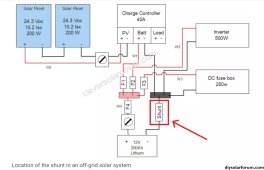daveoflave
New Member
Hi all,
I've set up a small system of a few panels, LiFEPo4 battery, charge controller and inverter (more details on the system below). It's meant to power my full sized refrigerator in my kitchen indefinitely (I live in a hurricane-heavy area in Florida; it's not to save money but rather for assurance that we'll always be ok with food regardless of the weather).
I power my fridge with this little solar system just fine for a few days. When it gets dark at night, battery starts draining, but doesn't get completely discharged, and starts charging in the morning faster than it's being consumed, so I can see it climb back up to about 100% by around noon. I check again at 5:30 PM or so (when it starts getting dark), battery is at 100% - awesome. After about the 3rd day or so, battery was at 100% at 5:30 PM, but by 11 PM that night - it's completely drained and I have to chagne the fridge back to the grid. Am I missing something in my setup? Am I just assuming the battery can handle this when it really can't?
The set up is this: 4 Ecoworthy panels at 200w, 10.83ah (max) apiece in parallel, connected over 30 ft of 8awg copper wire controlled by a Renogy 60A MPPT Rover Li charge controller connected to an Ecoworthy 12.8v 200ah LiFePo4 battery, and output to a Gearzaar 4000w 12v to 110v/120v AC inverter. Wiring from battery to charge controller and from battery to inverter is also 8awg.
I'm just confused - I'd understand if on that 3rd day (sometimes it's the 2nd, sometimes the 4th, its not consistent) the battery just wasn't at 100% (according to the charge controller, that is) when the sun goes down around 5:30 PM - but each of those days I check, it's always at max capacity at that time, but somehow just suddenly can't power the fridge through the night, and dies about 5-6 hours into the no-sunlight hours. It makes me worried the battery is damaged somehow, but maybe I just need to learn more. Would I benefit from adding batteries to make a small bank of them maybe? Should I trust the battery charge percentage I'm reading on the charge controller? Thanks in advance!
I've set up a small system of a few panels, LiFEPo4 battery, charge controller and inverter (more details on the system below). It's meant to power my full sized refrigerator in my kitchen indefinitely (I live in a hurricane-heavy area in Florida; it's not to save money but rather for assurance that we'll always be ok with food regardless of the weather).
I power my fridge with this little solar system just fine for a few days. When it gets dark at night, battery starts draining, but doesn't get completely discharged, and starts charging in the morning faster than it's being consumed, so I can see it climb back up to about 100% by around noon. I check again at 5:30 PM or so (when it starts getting dark), battery is at 100% - awesome. After about the 3rd day or so, battery was at 100% at 5:30 PM, but by 11 PM that night - it's completely drained and I have to chagne the fridge back to the grid. Am I missing something in my setup? Am I just assuming the battery can handle this when it really can't?
The set up is this: 4 Ecoworthy panels at 200w, 10.83ah (max) apiece in parallel, connected over 30 ft of 8awg copper wire controlled by a Renogy 60A MPPT Rover Li charge controller connected to an Ecoworthy 12.8v 200ah LiFePo4 battery, and output to a Gearzaar 4000w 12v to 110v/120v AC inverter. Wiring from battery to charge controller and from battery to inverter is also 8awg.
I'm just confused - I'd understand if on that 3rd day (sometimes it's the 2nd, sometimes the 4th, its not consistent) the battery just wasn't at 100% (according to the charge controller, that is) when the sun goes down around 5:30 PM - but each of those days I check, it's always at max capacity at that time, but somehow just suddenly can't power the fridge through the night, and dies about 5-6 hours into the no-sunlight hours. It makes me worried the battery is damaged somehow, but maybe I just need to learn more. Would I benefit from adding batteries to make a small bank of them maybe? Should I trust the battery charge percentage I'm reading on the charge controller? Thanks in advance!



